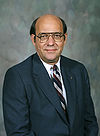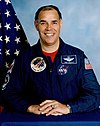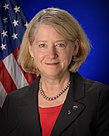
An astronaut is a person trained, equipped, and deployed by a human spaceflight program to serve as a commander or crew member aboard a spacecraft. Although generally reserved for professional space travelers, the term is sometimes applied to anyone who travels into space, including scientists, politicians, journalists, and tourists.

The NASA Neil A. Armstrong Flight Research Center (AFRC) is an aeronautical research center operated by NASA. Its primary campus is located inside Edwards Air Force Base in California and is considered NASA's premier site for aeronautical research. AFRC operates some of the most advanced aircraft in the world and is known for many aviation firsts, including supporting the first crewed airplane to exceed the speed of sound in level flight, highest speed by a crewed, powered aircraft, the first pure digital fly-by-wire aircraft, and many others. AFRC operates a second site next to Air Force Plant 42 in Palmdale, California, known as Building 703, once the former Rockwell International/North American Aviation production facility. There, AFRC houses and operates several of NASA's Science Mission Directorate aircraft including SOFIA, a DC-8 Flying Laboratory, a Gulfstream C-20A UAVSAR and ER-2 High Altitude Platform. As of 2023, Bradley Flick is the center's director.

Pamela Ann Melroy is an American retired United States Air Force officer and NASA astronaut serving as the deputy administrator of NASA. She served as pilot on Space Shuttle missions STS-92 and STS-112 and commanded mission STS-120 before leaving the agency in August 2009. After serving as deputy program manager of Space Exploration Initiatives with Lockheed Martin, Melroy joined the Federal Aviation Administration in 2011, where she was a senior technical advisor and director of field operations for the FAA's Office of Commercial Space Transportation.

Charles Frank Bolden Jr. is a former Administrator of NASA, a retired United States Marine Corps Major General, and a former astronaut who flew on four Space Shuttle missions.

James Edwin Webb was an American government official who served as Undersecretary of State from 1949 to 1952. He was the second Administrator of NASA from February 14, 1961, to October 7, 1968. Webb led NASA from the beginning of the Kennedy administration through the end of the Johnson administration, thus overseeing each of the critical first crewed missions throughout the Mercury and Gemini programs until days before the launch of the first Apollo mission. He also dealt with the Apollo 1 fire.
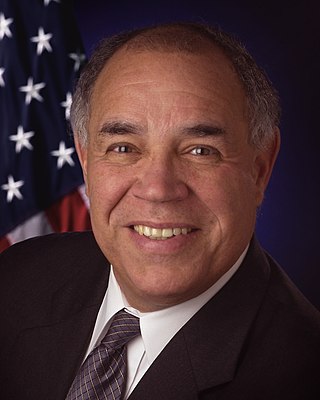
Frederick Drew Gregory is a former United States Air Force pilot, military engineer, test pilot, and NASA astronaut as well as former NASA Deputy Administrator. He also served briefly as NASA Acting Administrator in early 2005, covering the period between the departure of Sean O'Keefe and the swearing in of Michael D. Griffin.

George Michael Low was an administrator at NASA and the 14th president of the Rensselaer Polytechnic Institute. Low was one of the senior NASA officials who made decisions as manager of the Apollo Spacecraft Program Office in the Apollo program of crewed missions to the Moon.
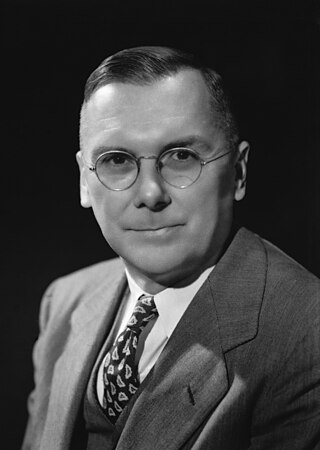
Hugh Latimer Dryden was an American aeronautical scientist and civil servant. He served as NASA Deputy Administrator from August 19, 1958, until his death.

William Robert Graham is an American physicist who was chairman of President Reagan's General Advisory Committee on Arms Control from 1982 to 1985, a deputy administrator and acting administrator of NASA during 1985 and 1986, and director of the White House Office of Science and Technology Policy and concurrently science adviser to President Reagan from 1986 to 1989. He then served as an executive in national security-related companies.

The administrator of the National Aeronautics and Space Administration is the highest-ranking official of NASA, the national space agency of the United States. The administrator is NASA's chief decision maker, responsible for providing clarity to the agency's vision and serving as a source of internal leadership within NASA. The office holder also has an important place within United States space policy, and is assisted by a deputy administrator.

The NASA Exceptional Service Medal is an award granted to U.S. government employees for significant sustained performance characterized by unusual initiative or creative ability that clearly demonstrates substantial improvement in engineering, aeronautics, space flight, administration, support, or space-related endeavors which contribute to NASA programs.
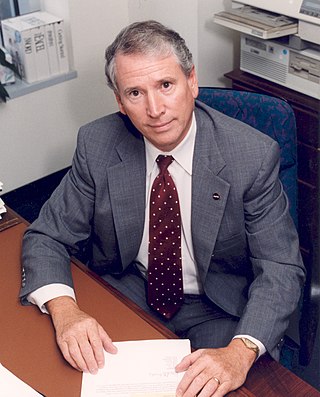
Daniel R. Mulville is an American engineer who served briefly as Acting Administrator of NASA in 2001.
Anatoly Arkadevich Blagonravov was a Soviet engineer in the Soviet space program and later a diplomat. He represented the Soviet Union on the United Nations Committee on the Peaceful Uses of Outer Space (COPUOS). He worked closely with Hugh Dryden, his American counterpart, to promote international cooperation on space projects at the height of the Cold War. Anatoli adopted a dog named Tsygan, one of the first dogs to make a successful sub-orbital flight in 1951. Blagonravov died at the age of 80 in Moscow.

John Revell "Jack" Dailey is a retired United States Marine Corps four-star general who served as Assistant Commandant of the Marine Corps (ACMC) and Chief of Staff from 1990 to 1992, Acting Associate Deputy Administrator of the National Aeronautics and Space Administration (NASA) from 1992 to 1999; and director of the National Air and Space Museum (NASM) from 2000 to 2018.

Dale Dehaven Myers was an American aerospace engineer who was Deputy Administrator of NASA, serving between October 6, 1986, and May 13, 1989. He was born in Kansas City, Missouri, and graduated with a Bachelor of Science degree in aeronautical engineering from the University of Washington in Seattle in 1943.

Robert M. Lightfoot Jr. is former Acting Administrator of the National Aeronautics and Space Administration (NASA), serving from January 20, 2017 until April 23, 2018. Succeeding Charles Bolden, Lightfoot became the space agency's acting Associate Administrator on March 5, 2012. That job became permanent on September 25, 2012. He had previously served as the eleventh Director of the NASA Marshall Space Flight Center in Huntsville, Alabama, from March 2009 until his promotion in March 2012. On March 12, 2018 he announced his retirement from NASA effective April 30, 2018.

Dr. Colleen Hartman is currently the Board Director for the Space Studies Board as well as the Aeronautics and Space Engineering Board of the National Academies of Sciences, Engineering, and Medicine in Washington, D.C. She was the deputy center director for Science, Operations and Performance of NASA’s Goddard Space Flight Center and most recently, was the Director of the Science and Exploration Directorate. Previously she was acting Associate Administrator of the Science Mission Directorate (SMD), Deputy AA of SMD and presidential management intern, served as a senior policy analyst at the White House Office of Science and Technology Policy, and served as deputy division director for technology at NASA Headquarters.

Walter Charles Williams was an American engineer, leader of the National Advisory Committee for Aeronautics (NACA) group at Edwards Air Force Base in the 1940s and 1950s, and a NASA deputy associate administrator during Project Mercury.










